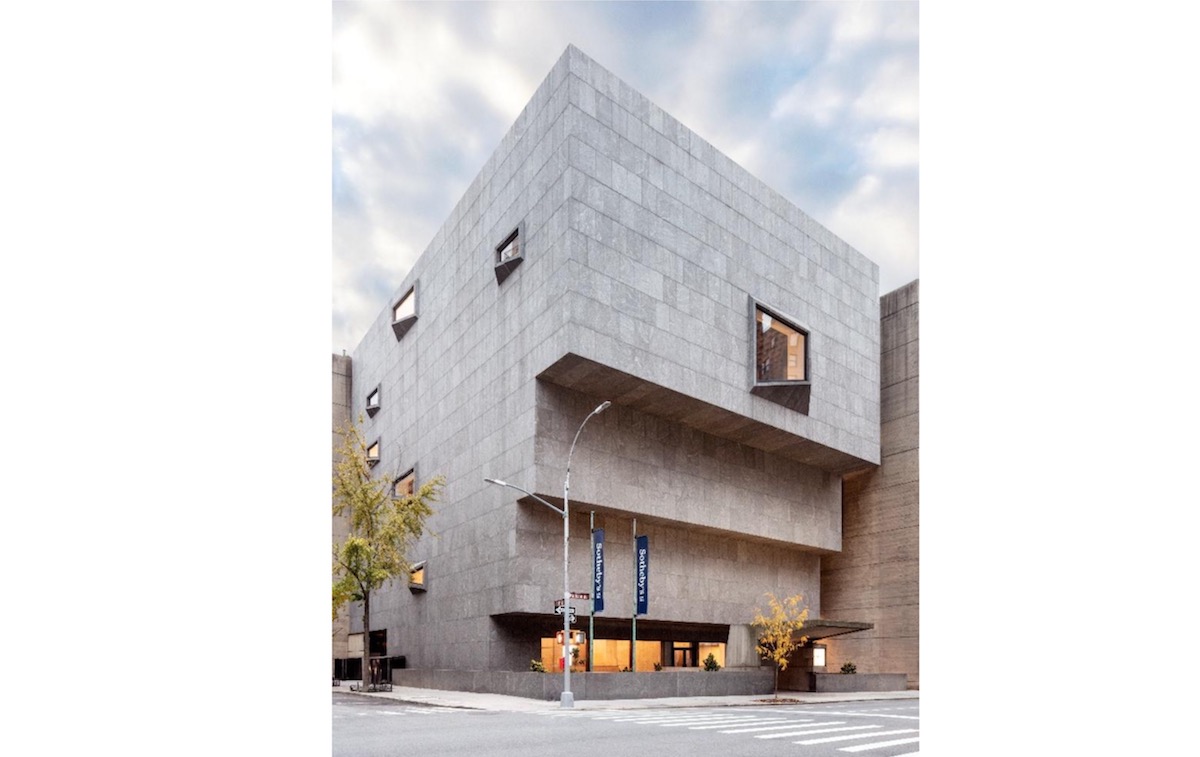New York: There’s something almost poetic about seeing the Breuer alive again — that hulking, cantilevered block of brutalist calm at 945 Madison Avenue. After years of rotating custodians — the Whitney, the Met Breuer, then the Frick — the building now enters a new chapter under Sotheby’s, which officially opens its global headquarters there on November 8. The auction house has been touting this as a “return to Madison Avenue,” but it’s more than that: it’s a reclamation of a space that’s always oscillated between commerce and culture.
Herzog & de Meuron, the Swiss firm whose name alone can elevate the pulse of an architectural critic, has reimagined the Breuer with their usual mix of reverence and restraint. They’ve done what few can manage — changing almost everything without appearing to change a thing.
“Our strongest architectural contribution was to remain quasi-invisible,” said Jacques Herzog, with the kind of understatement that only architects of global fame can afford. The building’s sculptural clarity, its granite gravity, remains intact, though the guts have been quietly replaced with flexible salesrooms, upgraded lighting, and climate control precise enough for a Monet.
The timing of the opening — in the thick of New York’s autumn auction season — is no coincidence. Sotheby’s intends to baptise the space not with speeches, but with spectacle. Over the next two weeks, the new Breuer galleries will play host to a parade of blue-chip art, some of it almost mythic in provenance.
![Sotheby’s fourth-floor Breuer galleries, featuring Gustav Klimt’s Blooming Meadow (Blumenwiese), Portrait of Elisabeth Lederer(Bildnis Elisabeth Lederer) and Waldabhang bei Unterach am Attersee (Forest Slope in Unterach on the Attersee), from The Leonard A. Lauder Collection [left to right] Photography by Stefan Ruiz Courtesy of Sotheby’s](https://artlyst.com/wp-content/uploads/2025/11/sothebys-klimt.jpg)
(Bildnis Elisabeth Lederer) and Waldabhang bei Unterach am Attersee (Forest Slope in Unterach on the Attersee), from
The Leonard A. Lauder Collection [left to right] Photography by Stefan Ruiz Courtesy of Sotheby’s
Then comes Exquisite Corpus, a private Surrealist collection that borders on museum-level ambition. At its centre: Frida Kahlo’s El sueño (La cama) — intimate, unnerving, unmistakably her. The sale opens on November 20. That same night, Sotheby’s will stage The Now & Contemporary Evening Auction, a high-octane mix of late twentieth and twenty-first-century icons. The star lot? Jean-Michel Basquiat’s Crowns (Peso Neto) (1981) is a firework of energy from the year he detonated onto the global stage. There’s also Maurizio Cattelan’s America (2016), that infamous 18-karat gold toilet once plumbed into the Guggenheim. In a neat stunt of auction theatre, bidding will begin at the artwork’s literal weight in gold.
Not to be outshone, the Modern Evening Auction on November 20 gathers works from the likes of Magritte, Monet, and Klein, with pieces drawn from philanthropic heavyweights — the Bucksbaums, the Brawermans, and others whose names are quietly embedded in the cultural life of Chicago and Aspen.
Inside, the experience feels part museum, part marketplace. Herzog & de Meuron’s reworking restores Breuer’s original gallery proportions, stripping away old office partitions and letting light breathe again through the deep-set windows. There’s a second-floor gallery that doubles as an event space and a discreet new restaurant (opening in the spring) by Roman and Williams. From the street, new lighting glows up the facade, reminding passersby that Madison Avenue’s most formidable block of stone still hums with life.
“It’s a privilege to inhabit a building that has hosted nearly six decades of art history,” said Lisa Dennison, Sotheby’s Executive Vice President and Chairman for the Americas. She isn’t exaggerating — few structures have seen such a rotation of cultural identities while retaining their soul. “Those who knew it in earlier incarnations will be moved by how we’ve reimagined it,” she added, noting that Breuer’s famously stubborn architecture, designed in the early 1960s, continues to accommodate new eras of art.
What’s striking about the reopening is how smoothly it bridges nostalgia with ambition. Sotheby’s, now owned by French-Israeli telecom magnate Patrick Drahi, has been on an aggressive modernisation spree — courting younger collectors, investing in digital platforms, and expanding across Asia. Yet the move back to Madison Avenue feels like a gesture of permanence, a physical anchor in a market increasingly lived online.
The Breuer building, for all its mass and material weight, has always been about motion — how ideas, artists, and institutions pass through it, each leaving behind a faint residue. Herzog & de Meuron’s version captures that flux, polishing it just enough for the next act. As Herzog put it, “The beauty and clarity of Breuer’s original work radiates — also in its new function — and ensures its relevance for future generations.”
For now, though, it’s about the present: Klimt, Van Gogh, Basquiat, Kahlo, Cattelan — the kind of names that turn a building reopening into an event. From November 8 to 21, the Breuer will once again be the gravitational centre of New York’s art world, its walls humming with old ghosts and new money.
Standing outside, as the light catches the granite angles of Breuer’s design, it’s easy to feel that overlap of art and commerce, idealism and investment — the same tension that’s kept this address on the cultural map for sixty years. Sotheby’s isn’t just reopening a building; it’s reclaiming a stage.

